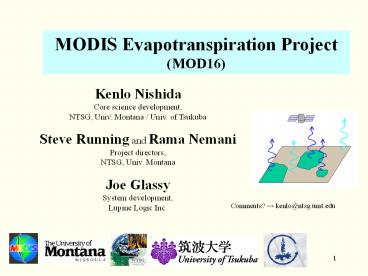MODIS Evapotranspiration Project (MOD16)
1 / 17
Title:
MODIS Evapotranspiration Project (MOD16)
Description:
1. MODIS Evapotranspiration Project (MOD16) Kenlo Nishida. Core ... Penman-Monteith & Complementary relation. VI. Ts. VI. Rd. Ta. albedo. Qbare. Tbare max. Ta ... –
Number of Views:400
Avg rating:3.0/5.0
Title: MODIS Evapotranspiration Project (MOD16)
1
MODIS Evapotranspiration Project (MOD16)
Kenlo Nishida Core science development, NTSG,
Univ. Montana / Univ. of Tsukuba Steve Running
and Rama Nemani Project directors, NTSG, Univ.
Montana Joe Glassy System development, Lupine
Logic Inc.
Comments? ? kenlo_at_ntsg.umt.edu
2
Why we need evapotranspiration (ET)?
ET How wet is there? Water resources
management drought monitoring - Water resource
crisis is biggest problem in 21st century. ----
ET consumes precious water resources!!! - Fire
risk assessment Improve Models - ET serves as
input data or validation data for climate
model. - Validation of ecosystem model
(Biome-BGC, RHESSys, etc.) Diagnose
environment - Urbanization ? change energy
budget ? hot city? (like Tokyo in summer) -
Cut/plant forest ? change energy budget ? change
climate productivity - Global warming ? ET
increase? Decrease?
3
Why ET by satellite?
- Score table of three approaches to ET
- --------------------------------------------------
--------------------------------------------------
---- Observation model satellite
RS-----------------------------------------------
--------------------------------------------------
------- - Time coverage Good! Good! Poor
- Spatial coverage Poor So-so. Good!
- Accuracy Good! So-so. So-so.
- Cost efficiency Poor So-so. So-so.
- --------------------------------------------------
--------------------------------------------------
---- - Particular advantage of satellite RS
- Not influenced by water re-distribution (e.g.,
irrigation)- Strong at phenology
4
Why is Aqua/MODIS good?
- Frequent global coverage (every day
combination with Terra/MODIS) - Afternoon overpass dry condition becomes
clearer than morning - High-spatial resolution (1km) cf. Microwave
remote sensing - High-precision of temperature and vegetation
indices cf. NOAA/AVHRR - albedo and emissivity are available. cf.
NOAA/AVHRR - Atmospheric information is available from other
sensors on Aqua - AIRS/AMSU/HSB accurate atmospheric profile!!!
5
Outline of the Project
Final Product EF (Evaporation Fraction)
values - 8 day-period, 1km resolution,
globally - by Aqua (EOS-PM)/MODIS Requirements
for the algorithm - Stand alone It can operate
only with optical satellite sensor data -
Flexible It can ingest any other reliable data,
if available. - Simple It is simply constructed
to reduce computational load. - Scalable It can
give daily information of ET from instants
data. - Versatility It can operate regardless
of climate and biome. - Sensor Independence It
can co-operate with other sensors with same
logic.
6
What is Evaporation Fraction?
Ground heat transfer
Available Energy
Net radiation (radiation absorbed on the land)
- Fractional value is representative for
wetness. - Scalability of instantaneous observation to
longer period. - Accurate estimate of Q is difficult.
Potential for coupling with Terra-MODIS (AM
overpass)
From Crago, 1996, Scaling up in Hydrology using
Remote Sensing
7
MODIS-ET Model Landscape
Actual landscape mixture of
forest, farm, grassland, road, etc.
Simplification
ETbare
ETveg
ET fveg ET veg (1 fveg) ET soil
Qveg
Qbare EF fveg ?? EFveg (1 fveg) ??
EFbare Q
Q
Fraction of bare soil 1.0 - fveg
Fraction of vegetation fveg
8
How do we get it?
- Temperature on vegetation Tveg (S) - Incoming
solar radiation PAR (T)
- radiative transfer of atmosphere (T)
- VI-Ts diagram (S)
Qveg
Qbare EF fveg ??? EFveg (1 fveg)
??? EFbare Q
Q
We want this!
- Vegetation Index NDVI or EVI (S)
Note (S) . Derived from Satellite (T) .
Estimated theoretically
9
Estimating EFveg (1) Concept
Central concept Evaporation from vegetation
(transpiration) is mostly controlled by stomata
opening (canopy resistance).
Assuming complementary relationship (ET PETPM
2PETPT PETPMPenmans PET PETPTPriestley-Tay
lors PET), we can get
Constant. 1.26
Derivative of saturated vapor pressure curve
(change with T)
a ? EFveg ??????????
? ? ( 1 rc / 2 ra)
Aerodynamic resistance
Psychrometric constant (slightly change with T)
Canopy resistance
10
Estimating EFveg (2) Canopy Resistance Model
1 / rc f1(T) f2(VPD) f3(PAR) f4(?) / rcMIN
Ideally,
Solar radiation
Temperature
Soil water
Humidity
Actually,
Change of VI
1 / rc f1(T) f3(PAR) / rcMIN
11
Estimating EFbare
satellite image
Ts
Tbare max
Warm Edge
Wind speed
Tbare
Window
Tbare max Tbare EFbare ??????? Tbare
max Tbare min
TvegTbare min
Air temperature
VI
VImax
VImin
VI
VI-Ts diagram (Nemani Running, 1989 1993)
Qbare0 ET Tbare
???????????? Ta 4esTa3 (1- CG) ?
Cp/ra bare
12
Data Stream
Satellite data
VI albedo
Channel reflectance
Thermal IR
Ts
Tbare max Tbare Ta
VI Ts
VI-Ts diagram
EFbare
fveg
VI
OrbitTa
Rd PAR
Radiative transfer model
Qbare Qbare0 Qveg
Rd Taalbedo
EF
Radiation budget
Qbare Tbare max Ta
U50m ra
Energy budget
Ta PAR
rc
Conductance model
Ta ra rc
Penman-Monteith Complementary relation
EFveg
13
Prototype
- NOAA/AVHRR 14-day composite (1km resolution)
- Window size 21km21km
- Validation 13 sites of AmeriFlux
14
(No Transcript)
15
Validation
Comparison of estimated EF by AVHRR and observed
EF at AmeriFlux sites
????????????????????????????????????????????
site (symbol) type data size R 2
bias standard error ??????????????????????
?????????????????????? Harvard Forest DBF
28 0.75 -0.05 0.13
Walker Branch DBF 29 0.88
0.01 0.13 Willow Creek
DBF 8 0.80 -0.14
0.18 WLEF Tower DBF 17
0.89 -0.18 0.20 Blodgett
ENF 11 0.30 -0.12
0.21 Duke Forest ENF 13
0.70 0.04 0.19 Howland
ENF 20 0.84 -0.02
0.10 Metolius ENF 15
0.20 -0.12 0.23
Bondville Crop 37 0.81
-0.07 0.19 Ponca Crop
6 0.36 -0.10 0.31
Little Washita Grass 20 0.86
0.04 0.14 Shidler
Grass 10 0.91 -0.03
0.12 Ski Oaks Shrub 16
0.29 -0.07 0.17 all sites
--- 230 0.74 -0.05
0.17 ???????????????????????????????????????????
?
16
Only NDVI
Full algorithm
Test of simplified algorithm
Validation for each landcover type
17
Prototype with Terra/MODIS
Day233, 2000North USA (Tile H10-12V04)































